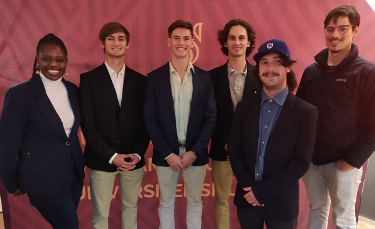From the 8th to the 22nd of August, the School of Data Science and Computational Thinking (SDSCT) at the University of Stellenbosch hosted its 5th hackathon in partnership with Standard Bank, Motus, and Differential Capital. The theme was “Patch Perfect: Using AI to fix roads” and the challenge was to build a model to predict the number of bags of asphalt needed to fill a pothole given an image of the pothole with a measuring stick next to it given relevant training data. Additionally, participants were asked how this model could be turned into a product, which required considering the user’s needs, scalability, profitability, and other factors. Dr Gray Manicom and Dr.Itai Makone from the Policy Innovation Lab, part of the School, assisted as a judge and the master of ceremonies, respectively.
Stellenbosch University students took part in teams of up to four members. There was a qualifying round to choose the top eight teams, who would then make a ten-minute pitch to stakeholders in the finals. In the qualifying round, judges considered source code, slides, model performance, and executive summaries that the teams submitted. The teams showed great creativity and insightfulness in their modelling approaches and product solutions. These included building 3D models of the potholes to estimate the volume, considering the smoothness of the pothole edges, and extracting significant features, such as road texture, that determine how much of the road surrounding a pothole requires asphalt. A wide range of modelling techniques was considered, most commonly regression models and convolutional neural networks. Some teams tried many models to find one that performed optimally, while others argued for a particular technique based on their insights and conversations with domain specialists. Most teams integrated their models into apps that citizens could use to take photos of potholes and record their location so that potholes could be repaired efficiently. While the training data had neither the quantity nor quality for training high-performing machine learning models, the finalists developed clever solutions to determining asphalt requirements for street repairs.
The teams that went on to the finals impressed the judges with their clear communication and effective presentations. Congratulations to all the finalists for their hard work and insightful solutions.
Fixing potholes and making our roads safer is one of the goals of SDG 9, and this hackathon is an example of how AI can help us achieve the sustainable development goals in South Africa.
Featured image: Photograph of the hackathon’s winning team, the Neural Navigators, with Dr. Makone (left) and Dr. Manicom (right).
